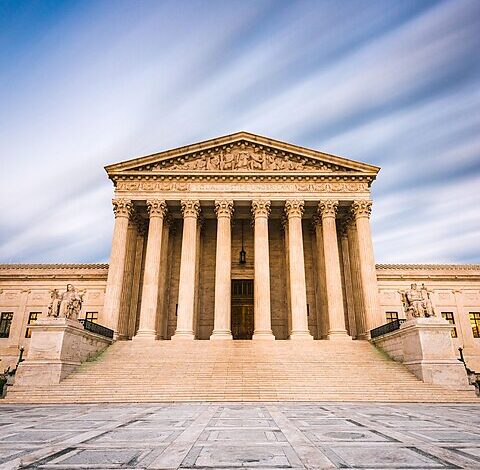The 2022-2023 Cato Supreme Court Review

Yesterday at the Cato Institute we celebrated Constitution Day with our annual symposium, which coincides with the release of the Cato Supreme Court Review. This was the 22nd edition of the Review, and my first as editor in chief. Every article from the Review is now available for free on online. Here’s a rundown of what’s on offer:
First up is the Foreword, written by my colleague Anastasia Boden, Director of Cato’s Robert A. Levy Center for Constitutional Studies. Boden writes that despite what critics of the Supreme Court may say, the modern Court is far from “activist.” If anything, she writes, the Court is still too hesitant to strike down laws that violate constitutional rights.
Next we have last year’s annual B. Kenneth Simon Lecture. Professor Akhil Reed Amar of Yale Law School offers 18 arguments for 18‐year term limits on the Supreme Court. Amar argues that term limits would have several beneficial effects, such as making presidential appointments of Supreme Court justices more regular and more predictable.
Next, Brannon Denning of Samford University Cumberland School of Law writes on National Pork Producers v. Ross. Even though the Court rejected a challenge to a California pork regulation under the “dormant Commerce Clause doctrine,” Denning explains why the doctrine is here to stay.
Margaret Little of the New Civil Liberties Alliance then covers the consolidated cases of Axon v. FTC and SEC v. Cochran, the latter of which she had a front‐row seat for as one of Cochran’s counsel. In both cases, the Court held that litigants can bring constitutional challenges to administrative agencies straight into federal court, without going through an agency proceeding first.
Next, Eric Franklin Amarante of the University of Tennessee College of Law writes on the term’s First Amendment overbreadth case, United States v. Hansen. Amarante criticizes the Court’s decision, which upheld the federal statute banning speech that encourages or induces violations of immigration law. Amarante argues that the majority opinion understated the harms caused by the “chilling effect” of a broadly worded law, harms that can’t be measured solely by counting the number of prosecutions under the law.
Christopher Green of the University of Mississippi School of Law then writes on 303 Creative v. Elenis. Most commentators have focused on the First Amendment aspects of this case, in which the Court held that a website designer may not be compelled by state law to design a custom site for a same‐sex wedding. Green points out that there is another issue at play, however, which is the scope of the traditional power of the state to compel access to public accommodations.
Continuing with the Court’s speech cases, Clay Calvert of the University of Florida Levin College of Law writes on Counterman v. Colorado. The Court held that to convict someone for making a threat, the First Amendment requires that the speaker must have been at least reckless to the risk that the message would be understood as a threat. Calvert notes that this was a middle‐ground position and that the Court could have required a higher mental standard or none at all—both positions that at least some on the Court espoused.
Next, David Bernstein of the Antonin Scalia Law School writes on the Term’s affirmative action cases, Students for Fair Admissions v. Harvard/UNC. Bernstein focuses in particular on the Court’s discussion of the racial categories that were used by universities and how those particular categories came to be standardized. This history, of which Bernstein is the leading expert, shows just how arbitrary these categories are.
Timothy Sandefur of the Goldwater Institute then tackles the Court’s Indian Child Welfare Act case, Haaland v. Brackeen. Sandefur explains why the Supreme Court’s decision is most notable for what it did not decide—whether the law violates the Equal Protection Clause of the Constitution. As Sandefur notes, the constitutional concerns with ICWA will not go away and will remain a live controversy in the courts.
Next, Jed Handelsman Shugerman of Boston University School of Law writes on Biden v. Nebraska, the student loans case. Shugerman argues that the Court reached the right result, because the Biden administration did not explain how the relief it wished to offer was tailored to the COVID-19 emergency specifically. Shugerman suggests that going forward, courts should develop a doctrine to evaluate claims of emergency power to ensure that emergencies are not used as pretexts to enact long‐term policy goals.
Moving to environmental law, Damien Schiff of Pacific Legal Foundation writes on Sackett v. EPA, a case he argued and won at the Supreme Court. Schiff relates the long history of the Clean Water Act and its mysterious statutory definition, “waters of the United States.” Multiple Supreme Court cases had considered what this definition means, but Sackett finally resulted in a majority of the Court setting out a clear test.
Next, Vikram David Amar of UC Davis School of Law tackles Moore v. Harper, the “independent state legislature doctrine” case. Amar argues that the Court’s rejection of the doctrine was clearly right as a matter of original constitutional meaning. Amar also explains the consequences that would have resulted if the Court had ruled the other way.
Wrapping up the articles on cases from this past Term, Gregory Dolin of the University of Baltimore School of Law covers Andy Warhol Foundation for the Visual Arts v. Goldsmith and Jack Daniel’s Properties v. VIP Products. In both cases, the Court narrowed the circumstances in which artists or parodists may adapt copyrighted or trademarked material without permission. Dolin argues that both cases were decided correctly and both can be understood as treating intellectual property similar to physical property.
Finally, Wen Fa of the Beacon Center of Tennessee authors our annual “Looking Ahead” article. Fa identifies several major cases to watch next term, on topics ranging from Chevron deference to an agency’s self‐funding powers, to the original meaning of “income” in the Sixteenth Amendment. The Court will also consider the First Amendment implications of public officials “blocking” citizens on social media and the standing of ADA online “testers.” Even though this past Term was undoubtedly a blockbuster, Fa suggests the sequel may end up being just as exciting.
Thank you to every author who contributed to another excellent edition of the Review. As in every edition, we hope it proves informative and illuminating for lawyers and non‐lawyers alike who wish to understand the most important decisions from the highest Court in the land.





